

Paleo-Tethys Ocean. Coal. Bituminous coal Coal (from the Old English term col, which has meant "mineral of fossilized carbon" since the 13th century)[1] is a combustible black or brownish-black sedimentary rock usually occurring in rock strata in layers or veins called coal beds or coal seams.
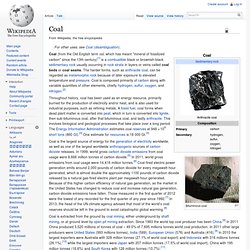
The harder forms, such as anthracite coal, can be regarded as metamorphic rock because of later exposure to elevated temperature and pressure. Coal is composed primarily of carbon along with variable quantities of other elements, chiefly hydrogen, sulfur, oxygen, and nitrogen.[2] Throughout history, coal has been used as an energy resource, primarily burned for the production of electricity and/or heat, and is also used for industrial purposes, such as refining metals. A fossil fuel, coal forms when dead plant matter is converted into peat, which in turn is converted into lignite, then sub-bituminous coal, after that bituminous coal, and lastly anthracite. Formation. Carboniferous. Subdivisions[edit] Late Pennsylvanian: Gzhelian (most recent) Noginskian / Virgilian (part) Late Pennsylvanian: Kasimovian.

Ural Ocean. Proto-Tethys Ocean. See also[edit] External links[edit]
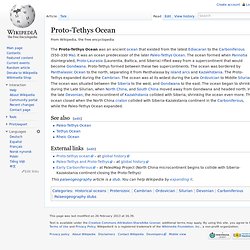
Rheic Ocean. The Rheic Ocean was a Paleozoic ocean between the large continent Gondwana to the south and the microcontinents Avalonia and others to the north.

It formed during the Cambrian and was destroyed during the Hercynian (European name) and Alleghenian (North American name) orogenies during the Carboniferous. Geodynamic evolution[edit] Basidiomycota. Classification[edit] The most recent classification[2] adopted by a coalition of 67 mycologists recognizes three subphyla (Pucciniomycotina, Ustilaginomycotina, Agaricomycotina) and two other class level taxa (Wallemiomycetes, Entorrhizomycetes) outside of these, among the Basidiomycota.
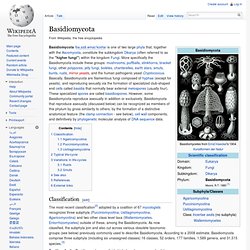
As now classified, the subphyla join and also cut across various obsolete taxonomic groups (see below) previously commonly used to describe Basidiomycota. According to a 2008 estimate, Basidiomycota comprise three subphyla (including six unassigned classes) 16 classes, 52 orders, 177 families, 1,589 genera, and 31,515 species.[3] Traditionally, the Basidiomycota were divided into two classes, now obsolete: Previously the entire Basidiomycota were called Basidiomycetes, an invalid class level name coined in 1959 as a counterpart to the Ascomycetes, when neither of these taxa were recognized as phyla. Mississippian. Calamites. Calamites is a genus of extinct arborescent (tree-like) horsetails to which the modern horsetails (genus Equisetum) are closely related.
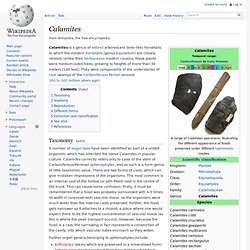
Unlike their herbaceous modern cousins, these plants were medium-sized trees, growing to heights of more than 30 meters (100 feet). They were components of the understories of coal swamps of the Carboniferous Period (around 360 to 300 million years ago). Taxonomy[edit] A number of organ taxa have been identified as part of a united organism, which has inherited the name Calamites in popular culture. Calamites correctly refers only to casts of the stem of Carboniferous/Permian sphenophytes, and as such is a form genus of little taxonomic value.
Further organ genera belonging to sphenophytes include: Arthropitys (stems which are preserved in a mineralised form)Astromyelon (permineralised rhizomes, distinguished from Arthropitys by the absence of a carinal canal)Annularia and Asterophylites (form genera of leaf-whorls which are paraphyletic). Cordaites. Cordaites is an important genus of extinct gymnosperms which grew on wet ground similar to the Everglades in Florida.
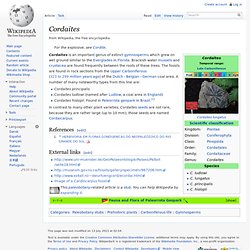
Brackish water mussels and crustacea are found frequently between the roots of these trees. The fossils are found in rock sections from the Upper Carboniferous (323 to 299 million years ago) of the Dutch - Belgian - German coal area. A number of many noteworthy types from this line are: Cordaites principalisCordaites ludlowi (named after Ludlow, a coal area in England)Cordaites hislopii. Found in Paleorrota geopark in Brazil.[1] Carboniferous Rainforest Collapse.
Permo-Carboniferous. The Permo-Carboniferous refers to the time period including the latter parts of the Carboniferous and early part of the Permian period.

Permo-Carboniferous rocks are in places not differentiated because of the presence of transitional fossils, and also where no conspicuous stratigraphic break is present. Permo-Carboniferous time, about 300 million years ago, was a period of great glaciation. Alleghanian orogeny. The Alleghanian orogeny, a result of three separate continental collisions.
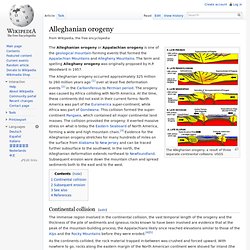
USGS The Alleghanian orogeny or Appalachian orogeny is one of the geological mountain-forming events that formed the Appalachian Mountains and Allegheny Mountains. The term and spelling Alleghany orogeny was originally proposed by H.P. Woodward in 1957. Variscan orogeny. Location of the Hercynian-Alleghenian mountain belts in the middle of the Carboniferous period.
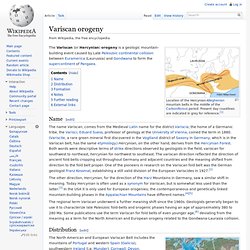
Present day coastlines are indicated in grey for reference.[1] Pangaea. Map of Pangaea with modern continents outlined Pangaea (/pænˈdʒiːə/ pan-JEE-ə;[1]) was a supercontinent that existed during the late Paleozoic and early Mesozoic eras, forming approximately 300 million years ago.[2] It began to break apart around 100 million years after it formed.[3] The single global ocean which surrounded Pangaea is accordingly named Panthalassa. Wegener's theory that mountains were made by two land masses colliding with each other seemed unlikely because it was thought that nothing could move a landmass as large as a continent. [6] The name occurs in the 1920 and 1922 editions of Die Entstehung der Kontinente und Ozeane, but only once, when Wegener refers to the ancient supercontinent as "the Pangaea of the Carboniferous".[7]
Panthalassa. Panthalassa (Greek πᾶν "all" and θάλασσα "ocean"[1]), also known as the Panthalassic Ocean, was the vast global ocean that surrounded the supercontinent Pangaea, during the late Paleozoic and the early Mesozoic eras. Amphibian. Evolutionary history[edit] Top: Restoration of Eusthenopteron, a fully aquatic lobe-finned fish Bottom: Restoration of Tiktaalik, an advanced tetrapodomorph fish The first major groups of amphibians developed in the Devonian period, around 370 million years ago, from lobe-finned fish similar to the modern coelacanth and lungfish,[2] which had evolved multi-jointed leg-like fins with digits that enabled them to crawl along the sea bottom. Some fish had developed primitive lungs to help them breathe air when the stagnant pools of the Devonian swamps were low in oxygen.
They could also use their strong fins to hoist themselves out of the water and onto dry land if circumstances so required. Ichthyostega was one of the first primitive amphibians, with nostrils and more efficient lungs. The Permian lepospondyl Diplocaulus was largely aquatic The temnospondyl Eryops had sturdy limbs to support its body on land. Reptile. The earliest known reptiles originated around 315 million years ago during the Carboniferous period, having evolved from advanced reptile-like amphibians that became increasingly adapted to life on dry land.